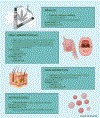Cannabis and Pregnancy: A Review
- PMID: 37480292
- PMCID: PMC10372687
- DOI: 10.1097/OGX.0000000000001159
Cannabis and Pregnancy: A Review
Abstract
Importance: Prenatal cannabis use is rising and is a major public health issue. Cannabis use in pregnancy and during lactation has been associated with increased maternal and offspring morbidity and mortality.
Objective: This review aims to summarize the existing literature and current recommendations for cannabis use during pregnancy or lactation.
Evidence acquisition: A PubMed, Cochrane Library, and Google Scholar literature search using the following terms was performed to gather relevant data: "cannabis," "cannabinoid," "delta-9-tetrahydrocannabinol," "THC," "cannabidiol," "fetal outcomes," "perinatal outcomes," "pregnancy," and "lactation."
Results: Available studies on cannabis use in pregnancy and during lactation were reviewed and support an association with increased risk of preterm birth, neonatal intensive care unit admission, low birth weight, and small-for-gestational-age infants.
Conclusion and relevance: There is a critical need for research on the effects of cannabis use in pregnancy and during lactation. This is a necessary first step before furthering patient education, developing interventions, and targeting antenatal surveillance to ameliorate the adverse impacts on maternal and fetal health.
Conflict of interest statement
The authors report no conflicts of interest
Figures
References
-
- Center for Behavioral Health Statistics and Quality. 2019 National Survey on Drug Use and Health: Detailed Tables. Substance Abuse and Mental Health Services Administration. September 11, 2020. Accessed February 19, 2023. https://www.samhsa.gov/data/report/2019-nsduh-detailed-tables.
Publication types
MeSH terms
Substances
Grants and funding
LinkOut - more resources
Full Text Sources




